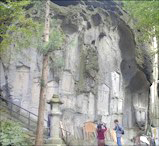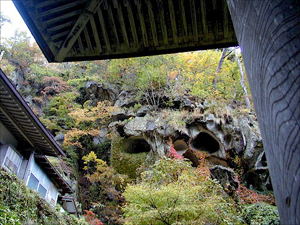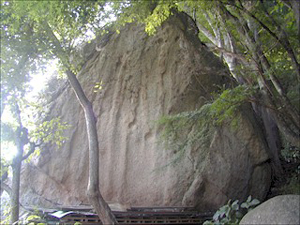閑さや岩にしみ入蝉の声
shizukasa ya
iwa ni shimiiru
semi no koe
How still it is here --
Stinging into the stones,
The locusts' trill.
(from The Narrow Road to Oku,
Donald Keene, translator)



A poem by Tu Fu says, "Cicadas' voices merge together at an old temple." Basho further enhanced the poetic beauty of the scene by introducing the image of rocks absorbing the voices. --Moran (1713-1779, haiku poet and chief priest of Myoho Temple in Shimousa)
Not a single sound was heard at this quiet place, except the voice of the cicadas that was so forceful that it seemed to seep into the rocks. --Sanga (Haiku poet who wrote a book on Basho in 1793)
If my sensibility is reliable, there should not be many circads here. -- Mizuho (1876-1955, tanka poet and classical scholar)
I disagree. The whole mountain is filled with the cicadas' screech. -- Watsuji (1889-1960, philosopher and scholar, an "intellectual leader of his generation")
In the word shimiiru ["to seep / stain into" -- Wallace] we sense motion in stillness, and stillness in motion. Basho, with his consummate art, captured this oneness of motion and stillness in a short poem. -- Ebara (1894-1948, scholar of renga and haikai at Kyoto University)
(excerpted from Basho and His Interpreters by Makoto Ueda)
Poetic technique -- alliteration in this poem
With the consonant "s" and the alternating vowels "i" (ee) and "e" (eh), Basho has brought together in this poem sounds that echo the actual sounds of cicadas and that metaphorically seem resonant with the concept of staining or seeping into something:
shizukasa ya iwa ni shimiiru semi no koe
(shee-zoo-ka-sah-yah / ee-wah knee / shee-mee-ee-roo seh-me no koh-eh)
Of course we cannot say exactly what Basho heard, nor would that necessarily be the final say in how he chose to write the poem even if we did know. Basho wrote and rewrote Oku no hosomichi, so we are in a poetic world, not just an empirical world, in this case of this poem and the work as a whole.
That being said, it might be useful here to make available some possible sounds. There is no agreement among scholars as to which of the many, many cicadas was singing at that time in that location, or indeed if only one species was prominant. Further, cicada songs vary from solo songs, to chorus, to "screeching" for each type of cicada. For a very complete, bilingual cicada web site go here. On a separate page (because of the file size they download extremely slowly for individuals with dialup, not cable, dsl or other internet connections) are .wav files of solo and chorus song for the two cicada which have been leading contenders for this temple at that time of year: aburazemi / Graptopsaltria nigrofuscata and niiniizemi / Platypleura kaempferi. Go here.